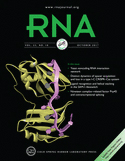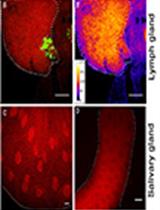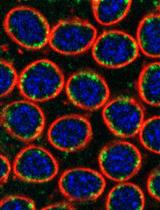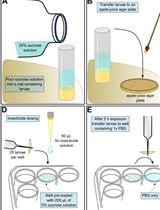- EN - English
- CN - 中文
Terminal Deoxynucleotidyl Transferase Mediated Production of Labeled Probes for Single-molecule FISH or RNA Capture
末端脱氧核苷酸转移酶介导的用于单分子FISH或RNA捕获的标记探针的生成
发布: 2018年03月05日第8卷第5期 DOI: 10.21769/BioProtoc.2750 浏览次数: 13502
评审: Gal HaimovichJoshua S TitlowKarthik Krishnamurthy
Abstract
Arrays of short, singly-labeled ssDNA oligonucleotides enable in situ hybridization with single molecule sensitivity and efficient transcript specific RNA capture. Here, we describe a simple, enzymatic protocol that can be carried out using basic laboratory equipment to convert arrays of PCR oligos into smFISH and RAP probesets in a quantitative, cost-efficient and flexible way.
Keywords: Terminal deoxynucleotidyl transferase (末端脱氧核苷酸转移酶)Background
The use of multiple, singly-labeled, short oligonucleotides of synthetic origin has vastly improved the detection of specific transcripts with high specificity and single molecule sensitivity (Femino et al., 1998; Raj et al., 2008). Such probe molecules have improved penetration and require milder hybridization conditions than the classically used long nucleic acid probes, resulting in better preservation of the structure of the specimen (e.g., Little et al., 2015, Gaspar et al., 2017a). Since in this design multiple oligonucleotides–typically 24-96–target different portions of the same transcript, there occurs an accumulation of signal on the specific target molecules over the aspecific background, as opposed to the equal signal produced by long multiply labeled probes (Raj et al., 2008). Moreover, as the labeling of the individual short probes is quantitative–as opposed to the stochastic labelling of the long probes–the signal intensity directly and linearly correlates with the transcript copy number at a given spot, allowing precise recording/counting of the target RNA molecules (Raj et al., 2008, Little et al., 2015). Until now, the production of smFISH probe arrays has depended on chemical synthesis and labeling that rendered such single molecule FISH application inflexible and costly. Here, we describe an effective and cost-efficient enzymatic three-pot probe production (3P3) assay that makes use of terminal deoxynucleotidyl transferase (TdT) and custom labeled terminator nucleotides to convert any custom-assembled array of cheap PCR oligos into smFISH probes bearing fluorescent or non-fluorescent labels of the experimenter’s choice (Gaspar et al., 2017b). These enzymatically produced 3P3 probes are chemically nearly identical to smFISH probes from other sources. Thus the same protocols–optimized for a given specimen under study–can be used to perform single molecule FISH (reviewed in Gaspar and Ephrussi, 2015) and RNA capture analyses(see e.g., Gaspar et al., 2017a and Khong et al., 2017).
Materials and Reagents
- 1.5 ml Eppendorf tube (e.g., Sigma-Aldrich, catalog number: Z336769 )
- 0.2 ml thin-walled PCR tube (e.g., Corning, catalog number: 6571 )
- 2 cm thick adhesive tape (Tesa)
- Glass slides (e.g., VWR, catalog number: 631-0411 ) and coverslips (e.g., 22 x 22 x 0.17 mm, Marienfeld-Superior, catalog number: 0107052 ) for sample preparation
- 15 ml tubes (e.g., Corning, Falcon®, catalog number: 352097 )
- 0.22 μm filter (e.g., Corning, catalog number: 431227 )
- 3 cm wide foldback paperclips (e.g., Staples, catalog number: WW-9130156 )
- Amine reactive labels (tested and working):
- BDP-FL-NHS (Lumiprobe, catalog number: 11420 )
- Atto-tec Atto488-NHS (Atto-tec, catalog number: AD 488-31 ), Atto532-NHS (Atto-tec, catalog number: AD 532-31 ), Atto565-NHS (Atto-tec, catalog number: AD 565-31 ) and Atto633-NHS (Atto-tec, catalog number: AD 633-31 )
- AlexaFluor488-NHS (Thermo Fisher Scientific, InvitrogenTM, catalog number: A20000 )
- Abberior STAR 470SXP-NHS (Abberior, catalog number: 1-0101-008-3 ) and Abberior STAR RED-NHS (Abberior, catalog number: 1-0101-011-3 )
- biotin-NHS (Sigma-Aldrich, catalog number: H1759 )
- BDP-FL-NHS (Lumiprobe, catalog number: 11420 )
- Anhydrous DMSO (e.g., Sigma-Aldrich, catalog number: 276855 )
- Optional: silica gel (e.g., Merck, catalog number: 1.01969.1000 ) (see Note 1)
- Amino-11-ddUTP (Lumiprobe, catalog number: 15040 ) or 5-propargylamino-ddUTP (Jena Biosciences, catalog number: NU-1619 )
- 1 M NaHCO3, pH 8.4 (e.g., Sigma-Aldrich, catalog number: S5761 )
- A custom designed target specific array of non-overlapping ssDNA oligonucleotides (desalting purification is sufficient, see Software section for the design)
- 20 U/μl Terminal deoxynucleotidyl transferase (TdT) with 5x TdT buffer (Thermo Fisher Scientific, Thermo ScientificTM, catalog number: EP0161 )
- 1-3 M Na-acetate, pH 5.5 (e.g., Sigma-Aldrich, catalog number: S2889 )
- 5 mg/ml linear acrylamide (e.g., Thermo Fisher Scientific, InvitrogenTM, catalog number: AM9520 )
- Ethanol (e.g., Merck, EMD Millipore, catalog number: 1.00983 )
- 100% ethanol, -20 °C
- 80% ethanol, 4 °C
- 70% ethanol, RT
- 100% ethanol, -20 °C
- Nuclease free ddH2O (e.g., New England Biolabs, catalog number: B1500S )
- 40% Acrylamide/Bis solution, 29:1 (e.g., Bio-Rad Laboratories, catalog number: 1610146 )
- Urea (e.g., Sigma-Aldrich, catalog number: U5378 )
- N,N,N’,N’-Tetramethylethylenediamine (TEMED) (e.g., Sigma-Aldrich, catalog number: T9281 )
- 10% (w/v) ammonium persulfate (APS) (e.g., Sigma-Aldrich, catalog number: A3678 )
- 6x gel loading dye (e.g., New England Biolabs, catalog number: B7021S )
- SYBR-GOLD (e.g., Thermo Fisher Scientific, InvitrogenTM, catalog number: S11494 )
- Optional: colorimetric Biotin Assay Kit (e.g., Sigma-Aldrich, catalog number: MAK171 ) (see Note 8)
- 20 mg/ml Proteinase-K (e.g., Thermo Fisher Scientific, InvitrogenTM, catalog number: AM2546 )
- Mounting medium
- VectaShield (Vector Laboratories, catalog number: H-1000 )
- 80% TDE (see Recipes)
- VectaShield (Vector Laboratories, catalog number: H-1000 )
- Pierce® Avidin agarose (Thermo Fisher Scientific, Thermo ScientificTM, catalog number: 20219 )
- Dynabeads® MyOneTM C1 (Thermo Fisher Scientific, InvitrogenTM, catalog number: 65001 )
- Quick-RNATM MicroPrep Kit (Zymo Research, catalog number: R1050 )
- Tris-HCl pH 7.0 (e.g., Sigma-Aldrich, Roche Diagnostics, catalog number: 10812846001 )
- Colorimetric Biotin Assay Kit (Sigma-Aldrich, catalog number: MAK171 )
- Tris base (e.g., Sigma-Aldrich, catalog number: T1503 )
- Ethylenediaminetetraacetic acid (EDTA) (e.g., Sigma-Aldrich, catalog number: E5391 )
- Sodium chloride (NaCl) (e.g., Merck, catalog number: 106404 )
- Potassium chloride (KCl) (e.g., Merck, catalog number: 104936 )
- Potassium dihydrogen phosphate dihydrate (KH2PO4·2H2O) (e.g., Merck, catalog number: 104873 )
- Sodium phosphate dibasic (Na2HPO4) (e.g., Merck, catalog number: 106342 )
- EM-grade paraformaldehyde (e.g., Electron Microscopy Sciences, catalog number: 15710 )
- Triton X-100 (e.g., Sigma-Aldrich, catalog number: X100 )
- Boric acid (e.g., Merck, catalog number: 100165 )
- Ethylene carbonate (e.g., Sigma-Aldrich, catalog number: E26258 )
- 50 mg/ml heparin (e.g., Sigma-Aldrich, catalog number: H3393 )
- 10 mg/ml salmon sperm DNA (e.g., Sigma-Aldrich, catalog number: D7656 )
- 2,2’-Thiodiethanol (Sigma-Aldrich, catalog number: 166782 )
- 20% (v/v) SDS (e.g., Sigma-Aldrich, catalog number: 05030 )
- PMSF (e.g., Sigma-Aldrich, catalog number: P7626 )
- cOmplete® mini EDTA-free protease inhibitor (Roche Diagnostics, catalog number: 11836170001 )
- RiboLock RNase Inhibitor (Thermo Fisher Scientific, Thermo ScientificTM, catalog number: EO0381 )
- Sodium citrate (e.g., Sigma-Aldrich, catalog number: S1804 )
- TE buffer (see Recipes)
- 1x PBS (see Recipes)
- Fixative (see Recipes)
- PBT (see Recipes)
- 1.5x PAGE loading buffer (see Recipes)
- 1x and 10x TBE (see Recipes)
- 15% PA - 8 M Urea stock (see Recipes)
- 20x SSC buffer (see Recipes)
- 2x full-HYBEC (see Recipes)
- 2x wash-HYBEC (see Recipes)
- Lysis buffer (see Recipes)
- Capturing hybridization buffer (see Recipes)
- Low salt wash buffer (see Recipes)
- High salt wash buffer (see Recipes)
- Elution buffer (see Recipes)
Equipment
- Optional: inert gas (e.g., Argon) glove-box (e.g., Inert Technology, model: PureLab HE 2GB ) (see Note 1)
- PCR machine with programmable hot-lid (e.g., Bio-Rad Laboratories, catalog number: 1851148 )
- -20 °C freezer
- Refrigerated table-top centrifuge (e.g., Eppendorf, catalog number: 5426000018 )
- Erlenmeyer flask
- Handcast PAGE system including a 1 mm spacer plate (e.g., Bio-Rad Laboratories, catalog number: 1653311 ), a short plate (e.g., Bio-Rad Laboratories, catalog number: 1653308 ) and a 15-well comb (e.g., Bio-Rad Laboratories, catalog number: 4560016 )
- Vertical Electrophoresis Cell (e.g., Bio-Rad Laboratories, catalog number: 1658005 )
- Electrophoresis power supply (e.g., Bio-Rad Laboratories, catalog number: 1645050 )
- Gel documentation system with filters to image fluorescence of SYBR-GOLD and the fluorescent dye used for labeling (e.g., Bio-Rad Laboratories, catalog number: 17001402 )
- P2, P200 and P1000 pipettes
- Rocking thermoblock (e.g., Eppendorf, model: ThermoMixer® C , catalog number: 5382000015)
- Microscope for imaging (we use a Leica SP8 (Leica, model: Leica TCS SP8 ) equipped with a 63x NA=1.4 oil immersion objective and two HyD detectors)
- Tissue grinder (e.g., DWK Life Sciences, Kimble, catalog numbers: 8853000015 or 8853000040 )
- Rotator (e.g., Cole-Parmer, Stuart, model: Rotator SB3 )
- Magnetic rack (e.g., New England Biolabs, catalog number: S1507S )
- Moisture free chamber (see Note 1)
- UV/VIS spectrophotometer (e.g., Thermo Fisher Scientific, Thermo ScientificTM, model: NanoDropTM 8000 , catalog number: ND-8000-GL)
- Nutator (e.g., Labnet International, model: S0500 )
Software
- A probe designer algorithm, e.g., the StellarisTM Probe Designer
(https://www.biosearchtech.com/support/tools/design-software/stellaris-probe-designer, registration required) or the provided smFISHprobe_finder.R script (Supplementary File 1, see Notes 2 and 17) - MS Office Excel to run the interactive probe_calculator.xls sheet (Supplementary File 2)
- ImageJ/FIJI (https://imagej.nih.gov/ij/) with the xsPT plugin (https://github.com/Xaft/xs/blob/master/_xs.jar)
- Optional: deconvolution software, e.g., Huygens Essentials (https://svi.nl/Huygens-Essential) or DeconvolutionLab2 (Sage et al., 2017; http://bigwww.epfl.ch/deconvolution/deconvolutionlab2/)
- R (preferentially with RStudio) for data analysis
- smFISH_analysis.R to analyze the sensitivity and specificity of smFISH (Supplementary File 3)
Procedure
文章信息
版权信息
© 2018 The Authors; exclusive licensee Bio-protocol LLC.
如何引用
Gáspár, I., Wippich, F. and Ephrussi, A. (2018). Terminal Deoxynucleotidyl Transferase Mediated Production of Labeled Probes for Single-molecule FISH or RNA Capture. Bio-protocol 8(5): e2750. DOI: 10.21769/BioProtoc.2750.
分类
发育生物学 > 细胞生长和命运决定 > 卵母细胞
细胞生物学 > 细胞成像 > 荧光
分子生物学 > RNA > RNA 检测
您对这篇实验方法有问题吗?
在此处发布您的问题,我们将邀请本文作者来回答。同时,我们会将您的问题发布到Bio-protocol Exchange,以便寻求社区成员的帮助。
Share
Bluesky
X
Copy link















